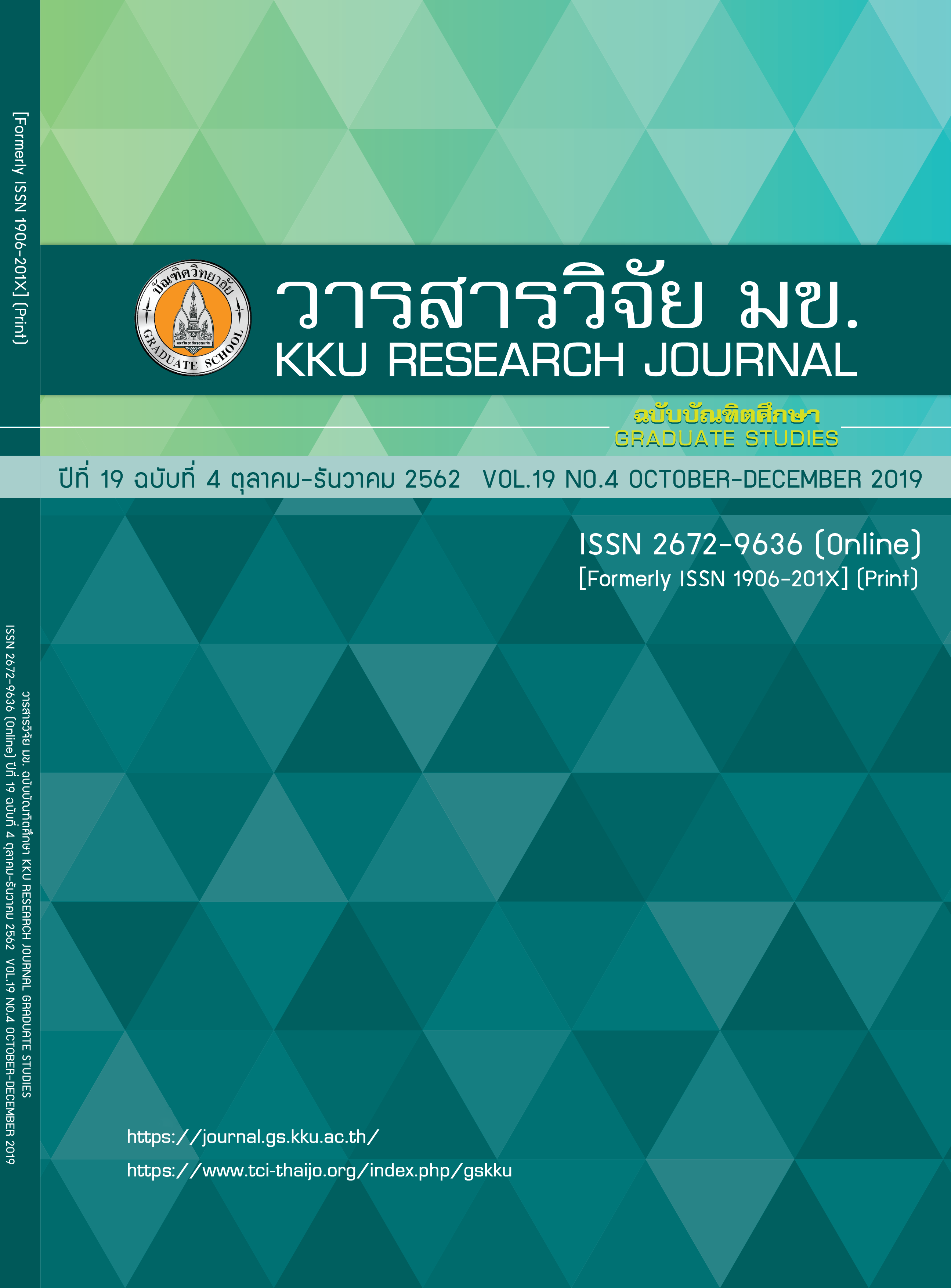Synthesis Of Composite Material Anode CdS/TiO2Nanotube
Keywords:
Titanium dioxide, Titanium dioxide Nanotube, Cadmium sulfideAbstract
Titanium dioxide is limited by its high energy bandgap. This work studied synthesis of Titanium dioxide nanotube and Cadmium sulfide on Titanium dioxide nanotube via hydrothermal method for enhancement photoactivity of Titanium dioxide. Investigated factors in this work are concentration of Sodium hydroxide 7-12 M, temperature 120-160oC time of hydrothermal 24-48 hours and ratio of Cadmium sulfide per Titanium dioxide 0.01:1 – 0.2:1. Then this work investigated specific surface area by Bruneur-Emmet-Teller (BET) method, the structure by Transmission Electron Microscopy (TEM), energy bandgap by UV–Visible Diffuse Reflectance Spectroscopy (UV–DRs) and crystal structure by X-ray Diffractometer (XRD). Efficiency of organic degradation was reported from degradation of methylene blue 300 mg/l. The optimum condition for synthesis of cadmium sulfide on titanium dioxide nanotube are 140 oC and ratio of cadmium sulfide to titanium dioxide 0.01:1 for the result of specific surface area 195.89 m2/g and. Cadmium sulfide on titanium dioxide nanotube has lower value of energy band gap to 2.2 eV, higher ability for light absorption and also wider range of absorption wavelength. The XRD result shows crystallinity structure of titanium dioxide anatase and cadmium sulfide in cadmium sulfide on titanium dioxide nanotube. Methylene blue removal by cadmium sulfide on titanium dioxide was at 68 and 46 percentage under UV light and visible light.
References
2. Pang YL, Lim S, Ong HC, Chong WT. A critical review on the recent progress of synthesizing techniques and fabrication of TiO2-based nanotubes photocatalysts. Appl Catal Gen. 2014 Jul 5;481:127–142.
3. Roy P, Berger S, Schmuki P. TiO2 Nanotubes: Synthesis and Applications. Angew Chem Int Ed. 2011 Mar 21;50(13):2904–2939.
4. Shei SC. Optical and Structural Properties of Titanium Dioxide Films from and Starting Materials Annealed at Various Temperatures. Vol. 2013. 2013. 1 p.
5. Camposeco R, Castillo S, Mejia-Centeno I, Navarrete J, Gómez R. Effect of the Ti/Na molar ratio on the acidity and the structure of TiO2 nanostructures: Nanotubes, nanofibers and nanowires. Mater Charact. 2014 Apr 1;90:113–120.
6. Lee J-H, Leu I-C, Hsu M-C, Chung Y-W, Hon M-H. Fabrication of Aligned TiO2 One-Dimensional Nanostructured Arrays Using a One-Step Templating Solution Approach. J Phys Chem B. 2005 Jul 1;109(27):13056–13059.
7. Ghicov A, Tsuchiya H, Macak JM, Schmuki P. Titanium oxide nanotubes prepared in phosphate electrolytes. Electrochem Commun. 2005 May 1;7(5):505–509.
8. Wu H-W. A review of recent development: Transport and performance modeling of PEM fuel cells. Appl Energy. 2016 Mar 1;165:81–106.
9. Lee HJ, Bang J, Park J, Kim S, Park S-M. Multilayered Semiconductor (CdS/CdSe/ZnS)-Sensitized TiO2 Mesoporous Solar Cells: All Prepared by Successive Ionic Layer Adsorption and Reaction Processes. Chem Mater. 2010 Oct 12;22(19):5636–5643.
10. Seo H-K, Kim G-S, Ansari SG, Kim Y-S, Shin H-S, Shim K-H, et al. A study on the structure/phase transformation of titanate nanotubes synthesized at various hydrothermal temperatures. Sol Energy Mater Sol Cells. 2008;92(11):1533–1539.
11. Luo J, Ma L, He T, Ng CF, Wang S, Sun H, et al. TiO2/(CdS, CdSe, CdSeS) Nanorod Heterostructures and Photoelectrochemical Properties. J Phys Chem C. 2012 Jun 7;116(22):11956–11963.
12. Raubach CW, de Santana YVB, Ferrer MM, Longo VM, Varela JA, Avansi W, et al. Strutural and optical approach of CdS@ZnS core–shell system. Chem Phys Lett. 2012 May 21;536:96–99.
13. Pandya S. PREPARATION AND CHARACTERIZATION OF CADMIUM SULPHIDE NANOCRYSTALLINE THIN FILM GROWN BY CHEMICAL METHOD. Vol. 7. 2016. 14887 p.
14. Wang B, Zhang H, Lu X-Y, Xuan J, Leung MKH. Solar photocatalytic fuel cell using CdS–TiO2 photoanode and air-breathing cathode for wastewater treatment and simultaneous electricity production. Chem Eng J. 2014 Oct 1;253:174–182.
15. Chen Y, Wang L, Lu G (Max), Yao X, Guo L. Nanoparticles enwrapped with nanotubes: A unique architecture of CdS/titanate nanotubes for efficient photocatalytic hydrogen production from water. J Mater Chem. 2011;21(13):5134–5141.
16. Yu L, Wang D, Ye D. CdS nanoparticles decorated anatase TiO2 nanotubes with enhanced visible light photocatalytic activity. Sep Purif Technol. 2015 Dec 17;156:708–714.
17. Manique MC, Silva AP, Alves AK, Bergmann CP. TITANATE NANOTUBES PRODUCED FROM MICROWAVE-ASSISTED HYDROTHERMAL SYNTHESIS: CHARACTERIZATION, ADSORPTION AND PHOTOCATALYTIC ACTIVITY. Braz J Chem Eng. 2017;34:331–339.
18. Jiang B, Yang X, Li X, Zhang D, Zhu J, Li G. Core-shell structure CdS/TiO2 for enhanced visible-light-driven photocatalytic organic pollutants degradation. J Sol-Gel Sci Technol. 2013 Jun 1;66(3):504–11.
19. Yan J, Zhou F. TiO2 nanotubes: Structure optimization for solar cells. J Mater Chem. 2011;21(26):9406–18.
20. Li X, Chen X, Niu H, Han X, Zhang T, Liu J, et al. The synthesis of CdS/TiO2 hetero-nanofibers with enhanced visible photocatalytic activity. J Colloid Interface Sci. 2015 Aug 15;452:89–97.
21. Bavykin DV, Parmon VN, Lapkin AA, Walsh FC. The effect of hydrothermal conditions on the mesoporous structure of TiO2 nanotubes. J Mater Chem. 2004;14(22):3370–3377.
22. Sreekantan S, Wei LC. Study on the formation and photocatalytic activity of titanate nanotubes synthesized via hydrothermal method. J Alloys Compd. 2010 Feb 4;490(1):436–442.



